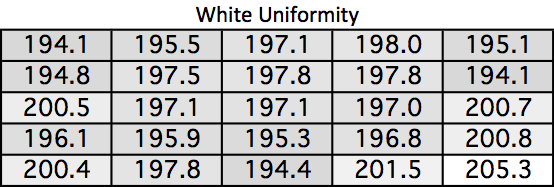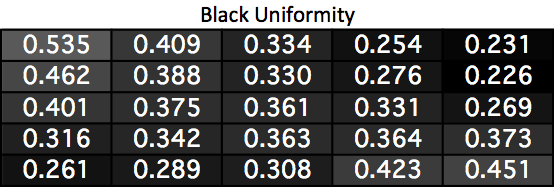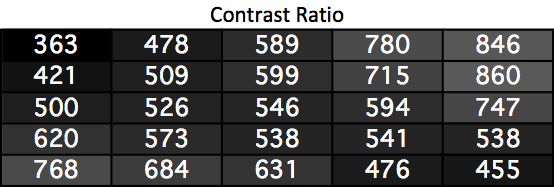NEC PA242W Monitor Review
by Chris Heinonen on September 27, 2013 9:00 AM ESTWith the switch to CalMAN we have been able to use much better methods for measuring display uniformity. Instead of getting unique dE2000 values for each point on the screen, they are compared to the center of the screen to give us a true uniformity value. We also measure 24 patches so we have a much more accurate idea of overall color and brightness uniformity than just measuring white level. Now with the test data from the NEC PA242W, I can finally use it to show why a professional monitor costs so much more.


Look at the white uniformity data. I usually am very happy if nothing varies from the center by more than 10%. On the NEC PA242W the maximum variation is 4.2%. A white field on the screen is white, and it is the same level everywhere. No monitor before has come close to this performance, which is a testament to the design of the NEC backlight setup.


Black uniformity is not nearly as good as white. Two corners are much darker and two are much lighter than the center. I’m surprised by this as good uniformity usually works both ways, but it seems that white uniformity is being judged to be more important overall than black uniformity here.


Since the white uniformity was almost perfect, this is just a mirror of the black uniformity chart. Two corners have much higher contrast ratios and two are much worse. It’s a bit disappointing just like the black uniformity is.

The color error uniformity is not disappointing at all. Instead, it is practically perfect. No area of the screen has an average dE2000 error >1 compared to the center. Since an error less than 1 is invisible to the eye, even on still images, this really is perfect. Even if the numbers were lower you wouldn’t see a difference, so I will just say this is perfect.
Uniformity like this has not been seen in my testing before. This performance is what professional designers and photo editors’ need, and it is what NEC delivers. It is expensive, but for many people it is worth paying for as it has untouched uniformity performance.










74 Comments
View All Comments
DanNeely - Friday, September 27, 2013 - link
Defect rates on an 8k panel would probably be prohibitive.ZeDestructor - Friday, September 27, 2013 - link
I'm curious on how high they are...If it remains withing tolerable limits, I'd happily take upto 200 dead pixels or something similar...
MrSpadge - Saturday, September 28, 2013 - link
Let's talk again once you have a few dozen permanently white, red green or blue dots right in your primary viewing area!ddriver - Saturday, September 28, 2013 - link
As long as the pixels aren't clustered in a small region dead (dark) pixels will probably not be distinguishable. Stuck bright pixels are a different matter, but at that pixel pitch shouldn't be that much annoying too.ZeDestructor - Saturday, September 28, 2013 - link
As ddriver said,, as long as it isn't in a cluster, its fine. 200-400 dead pixels spread out over a 440+ppi 24" panel at 30-60cm (my view distances for a desktop) will be pretty hard to spot..SodaAnt - Friday, September 27, 2013 - link
I know that I've seen an 8K prototype at 30" before at least, and it was pretty damn beautiful, but as far as I know, the (well known) company that made it hasn't brought it to market yet.speconomist - Friday, September 27, 2013 - link
You mean 32K, as the 20''monitor is 16 times larger than a 5'' inches monitor.garadante - Friday, September 27, 2013 - link
No, it'd be 8k. Yes, it would be 32 megapixels (roughly) but 4k doesn't mean 4 megapixels. It means 4k pixel width. So 8k pixel width is the same as a 1080p panel stacked 4 wide, 4 high.BlakKW - Saturday, September 28, 2013 - link
I would really like to understand your analogy of 4 wide, 4 high...it would help me remember the reason 4k is better and how this scales when you add a "k". Also, I've seen it argued that even 4k exceeds the human eye's ability to differentiate, so at what point does "everyone" agree you can't tell the difference?ZeDestructor - Saturday, September 28, 2013 - link
4 wide, 4 high he means in terms of "stitching" 1920x1080 (2Kx1K resolution, abbreviated to 2K in some circles, 1080p elsewhere) panels, leading to an effective resolution of 7680x4320 (8Kx4K naming).When I was referring to a panel sizes, I was referring to the diagonal measurement, as most things are quoted/marketed/sold using that measure. Thus 20" = 16 5" panels.
"4k is better and how this scales when you add a "k". " It doesn't. K stands for "kilo", the x1000 prefix.